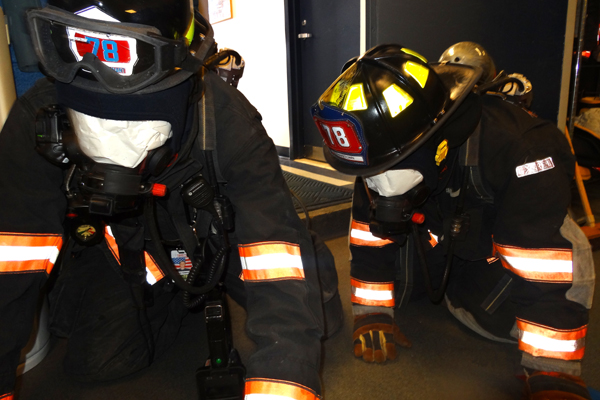Whether you are training for primary search or actually conducting it, there are two core requirements that you should impose upon yourself in order to ensure acceptable chances of your own survival. Sadly, these two requirements are not so much widespread and understood in modern fire service and this is why I have included them in my revised formal definition of primary search which we have learned before.
Let me present these two fundamental requirements once again. They are:
|
All your training should be always done in the combination of these two conditions and all the methods that you use for searching should be suitable for this too. Do anything less than that and now you are on the dangerous path to your last and fatal primary search attempt. It might not happen tomorrow, but it can happen sooner or later because buildings on fire will not endlessly bother to accommodate you with good visibility and perfectly predictable layout.
You should train for these two worst conditions so that they become normal working environment for you – this way you will handle them without distress when they happen in real combat, and you will handle better conditions, which, yes, will happen most of the time, like a boss.
If you are complaining that everyday blindfolded training in surprise layout is too tough on you, well, frankly, I would not want you on my search team, and I certainly would not want you on my rapid intervention team. It is unacceptable that a modern firefighter becomes incapacitated or slows down to the point of almost no progress the moment the visibility is lost. Fires will not forgive our laziness and desire for comfort indefinitely.
I insist on these two core requirements because it is exactly one or both of these conditions that kill firefighters in primary search. Rarely firefighters die while they have full visibility and know the layout well.
All my training is done with obscured masks, no exceptions, even for probies. In fact, I want my probies to embrace zero visibility as a new norm from day one, so that they grow to be comfortable with it and even enjoy it. I don’t want them to be surprised by it in real fire. I do this not because I am a tough instructor, I do this because I care about my firefighters and want them to retire alive and healthy when the time comes.
Before we move on to the next topic, let me address two common “escape” objections to my two core requirements. One is “Zero visibility? Didn’t they buy you a thermal imager?” and another one is “Unknown layout? Do you homework and know your response area!”.
Both have a degree of validity, but not a full degree. Let me parse them one-by-one.
First, thermal imagers. Yes, by now they are quite good already and getting even better. In fact, I am an active proponent of the idea that in modern fire service your Chiefs should buy you enough of these gadgets so that every team has at least one, preferably two thermal imagers. But understand that they are not magic “night vision goggles” that make you see everything. They have narrower field of view compared to what your brain is used to, they also don’t give you an image equivalent to the one that you normally see in visible portion of electromagnetic spectrum, they are prone to reflections off of unexpected surfaces and their batteries will quit on you just when you need your TIC the most. So, thermal imaging is invaluable for assessing the fire conditions, for locating your targets (victims), for keeping track of your team members, but they should never be used as the only or primary navigation device. Because if you commit to the building relying only on your TIC, once it quits on you, you will be completely disoriented.
Now to the topic of knowing your response area. Here too, I am the biggest proponent of driving around your neighborhood in the fire truck making new friends with people we serve, and studying their layouts, if they don’t mind. But not everyone will let you in, especially private residences are not obligated to open their doors at all. Secondly, some people will do illegal partitioning or renovations and you might not learn about it until you are inside fighting a fire. So, yes, gather as much intelligence as you can, but just like with TICs, don’t solely rely on it. Only use those search methods that will not fail even on arbitrary layout that you can’t see.






